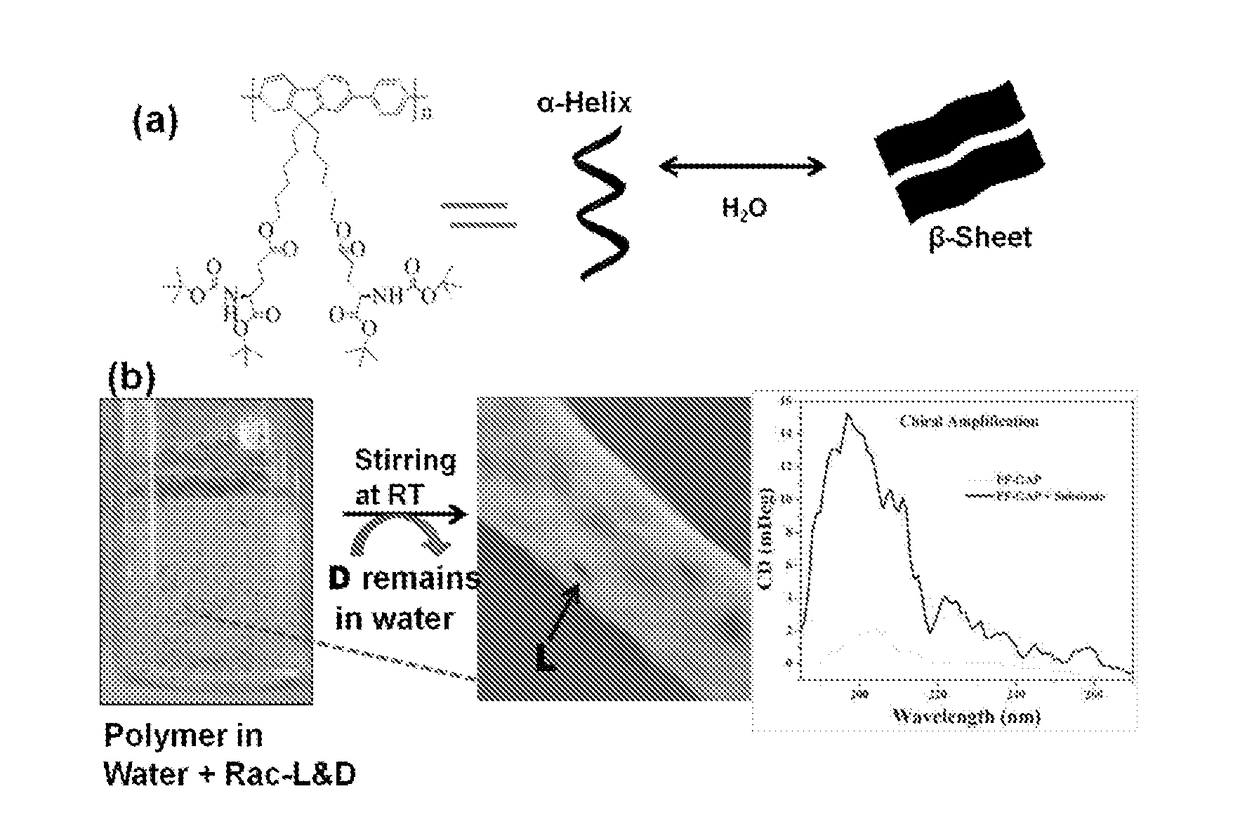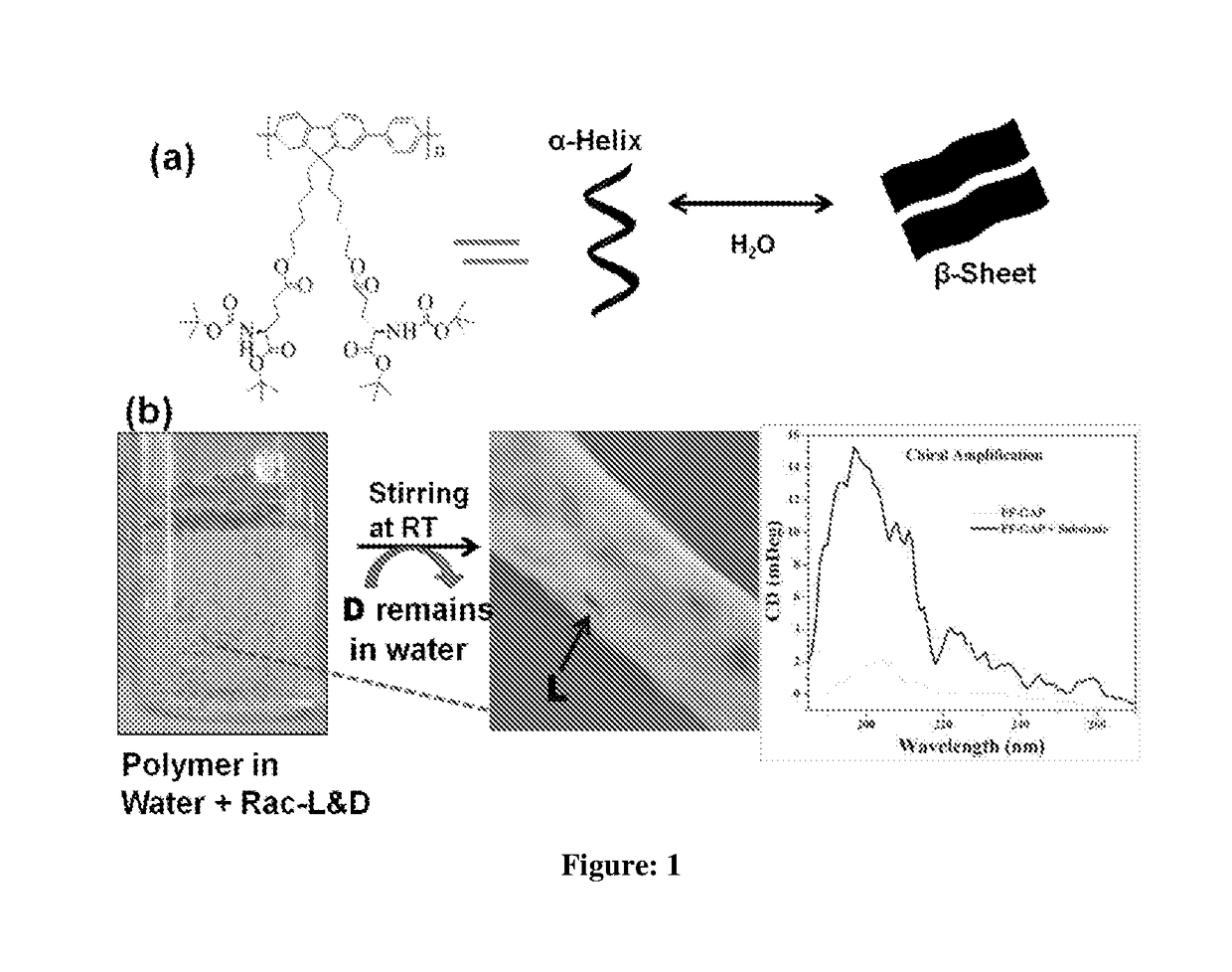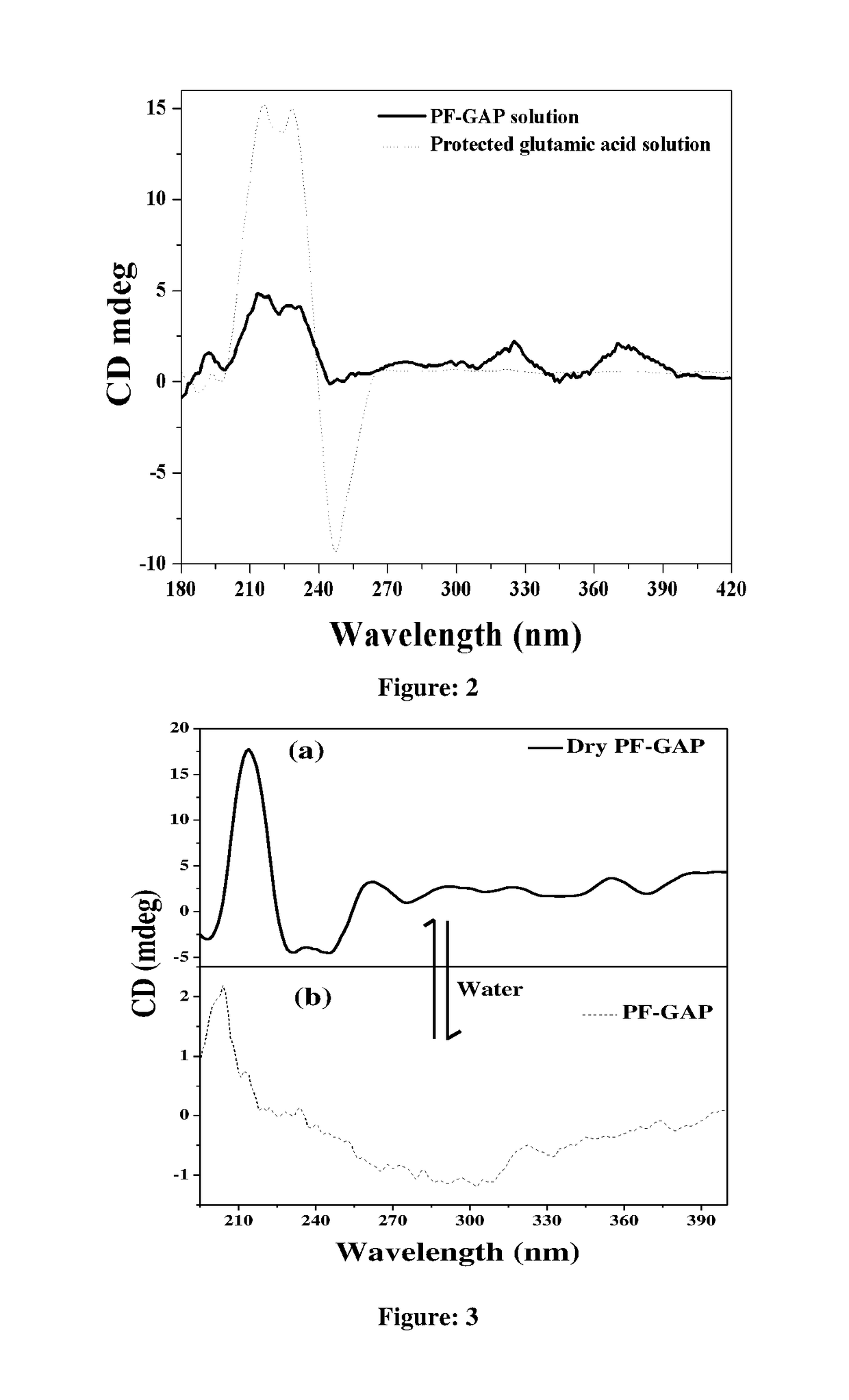A novel chiral polymer for enantioselective separation and process for preparation thereof
a chiral polymer and enantioselective separation technology, applied in the field of homochiral polymers for heterogeneous enantioselective separation and sensing of compounds, can solve the problems of narrow analyte window range, difficult to grow homochiral metal organic framework, and chirality sensing and enantioselective separation limitations
- Summary
- Abstract
- Description
- Claims
- Application Information
AI Technical Summary
Benefits of technology
Problems solved by technology
Method used
Image
Examples
examples
[0100]A. Materials: 2,7-dibromofluorene, 6-bromo-1-hexanol, 4-dimethyl amino pyridine dicyclohexyl carbo diimide (DCC), Tetrabutyl ammonium bromide, o-phthaldialdehyde, Phosphate buffered saline, trifluoro acetic acid, Pd(PPh3)4, and 1,4-benzene diboronic bis(pinacolatoester) were purchased from sigma Aldrich. boc-L-glutamic acid-1-tert butyl ester was purchased from Alfa Aesar chemical Ltd & co. NaOH, Na2CO3, K2CO3 and 2-mercaptoethanol were purchased from Merck chemicals. Toluene, THF, methanol, DCM, ethylacetate and pet ether were purchased locally and dried by the standard drying procedures. HPLC grade acetonitrile, hexane, 2propanol and methanol were purchased from Merck chemicals.[0101]B. Methods: NMR spectrum was analyzed using Bruker-AVENS 400 MHz spectrometer. Chemical shifts are reported in ppm at 25 ° C. using CDCl3 and DMSO-d6 solvents containing trace quantity of tetramethylsilane (TMS) as internal standard. The MALDI-TOF analysis was done on Voyager-De-STR MALDI-TOF (A...
examples 1
Synthesis of 2,7-dibromo-9,9-di-n-hexanolfluorene (1)
[0105]2,7-dibromofluorene (6 g, 18.52 mmol), 6-bromohexan-1-ol (8.3 g, 46.3 mmol) and tetrabutyl ammonium chloride (3 g, 9.26 mmol) were taken in two neck round bottom flask and dissolved in toluene(120 ml). Then 60 g of 50 wt % of aqueous NaOH solution were added to the reaction mixture and heated to 120° C. under argon atmosphere for 18 h. After cooling to room temperature, water was added and the aqueous layer was extracted with diethyl ether. The toluene layer was extracted with water until the color of the solution turns yellow. The aqueous layer was again extracted with diethyl ether. The ether layer was dried over sodium sulphate and evaporated under reduced pressure. The crude product was purified by column chromatography with hexane:ethyl acetate (97:3). Yield-92%. 1HNMR spectrum (200 MHz, CDCl3) δ 7.6-7.3 (m, 6H), δ 3.50 (t, 4H), δ 1.93-1.87 (m, 4H), δ 1.66-1.56 (m, 4H), δ 1.35 (m, 4H), δ1.08 (m, 4H), 0.56 (m, 4H).
examples 2
Synthesis of (S)-1-tert-butyl-5-(6-(2,7-dibromo-9-(6-4(R)-5-(tert-butoxy)-4-((tert-butoxycarbonyflamino)-5-oxopentanoyl)oxy)hexyl)-9H-fluoren-9-yl)hexyl)2-((tert-butoxycarbonyl)amino)pentanedioate (2)
[0106]4-dimethyl amino pyridine (2.56 g, 21 mmol) and boc-L-glutamic acid-1-tert butyl ester (7.24 g, 23.85 mmol) were taken in two neck round bottom flask under argon atmosphere. Dry DCM was added to the reaction mixture and the RB was cooled to 0° C. After 5 minutes dicyclohexyl carbo diimide (DCC) was added and the whole mixture was stirred for lh at the same temperature. 2,7-dibromo-9,9-di-n-hexanol fluorene was added to reaction mixture at 0° C. and RB was warmed to room temperature and stirred for 16 h. Reaction mixture was diluted with DCM and the organic layer was extracted twice with 0.02 M NaOH. The organic layer was extracted twice with saturated NaHCO3. Organic layer was washed with brine, water and finally evaporated under reduced pressure. The product was purified by colum...
PUM
| Property | Measurement | Unit |
|---|---|---|
| temperature | aaaaa | aaaaa |
| pore sizes | aaaaa | aaaaa |
| angle | aaaaa | aaaaa |
Abstract
Description
Claims
Application Information
 Login to View More
Login to View More - R&D
- Intellectual Property
- Life Sciences
- Materials
- Tech Scout
- Unparalleled Data Quality
- Higher Quality Content
- 60% Fewer Hallucinations
Browse by: Latest US Patents, China's latest patents, Technical Efficacy Thesaurus, Application Domain, Technology Topic, Popular Technical Reports.
© 2025 PatSnap. All rights reserved.Legal|Privacy policy|Modern Slavery Act Transparency Statement|Sitemap|About US| Contact US: help@patsnap.com



